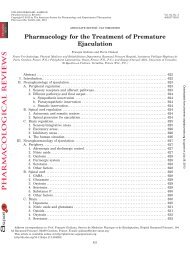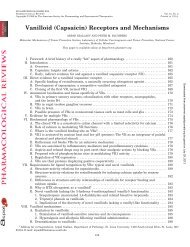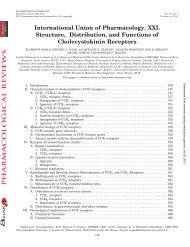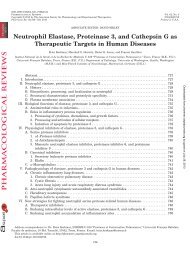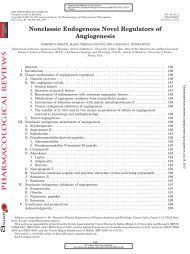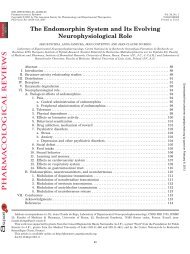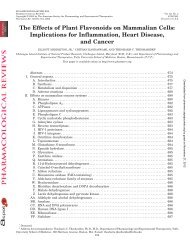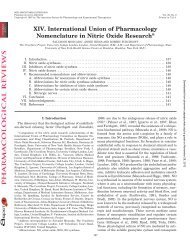Opioids, Reward and Addiction: An Encounter of Biology ...
Opioids, Reward and Addiction: An Encounter of Biology ...
Opioids, Reward and Addiction: An Encounter of Biology ...
You also want an ePaper? Increase the reach of your titles
YUMPU automatically turns print PDFs into web optimized ePapers that Google loves.
cholinergic antagonist atropine on i.v. morphine selfadministration<br />
in rats (Davis <strong>and</strong> Smith, 1975; Glick<br />
<strong>and</strong> Cox, 1975). Self-administration <strong>of</strong> morphine was<br />
accompanied by an increased acetylcholine turnover<br />
rate in limbic regions (Smith et al., 1980, 1984).<br />
Treatment with the DA--hydroxylase inhibitors, diethyldithiocarbamate,<br />
U-14,624, or FLA-57, suppressed<br />
the voluntary ingestion <strong>of</strong> morphine <strong>and</strong> prevented the<br />
reacquisition <strong>of</strong> i.v. morphine self-administration in rats<br />
(Davis et al., 1975; Brown et al., 1978). These treatments<br />
produced a concomitant reduction in central norepinephrine<br />
levels.<br />
Using a 1-day i.v. self-administration procedure in<br />
drug-naive mice, it was demonstrated that s.c. treatment<br />
with the dihydropyridine calcium channel antagonists<br />
isradipine <strong>and</strong> nimodipine, <strong>and</strong> the agonist BayK<br />
8644, decreased <strong>and</strong> increased, respectively, i.v. morphine<br />
self-administration (Kuzmin et al., 1992b, 1994,<br />
1996a). It was suggested that the inhibition <strong>of</strong> the reinforcing<br />
properties <strong>of</strong> morphine (<strong>and</strong> cocaine) is due to the<br />
ability <strong>of</strong> the calcium antagonists to block L-type calcium<br />
channels, thereby affecting the turnover or release<br />
<strong>of</strong> neurotransmitters (Martellotta et al., 1994; Kuzmin<br />
et al., 1996b).<br />
Systemic ibogaine, a naturally occurring indole alkaloid,<br />
produced an acute dose-dependent depression <strong>of</strong> i.v.<br />
opioid self-administration in rats. Although this action<br />
may be due to decreasing the reinforcing properties <strong>of</strong><br />
opioids, it may also be related to the acute nonspecific<br />
side effects <strong>of</strong> ibogaine (e.g., tremors, decreased motivated<br />
behavior) interfering with lever-pressing (Glick et<br />
al., 1991; Dworkin et al., 1995). A day after ibogaine<br />
administration the rates <strong>of</strong> opioid self-administration<br />
were still significantly decreased, although others disagree<br />
(Glick et al., 1991; Dworkin et al., 1995). This<br />
“aftereffect” <strong>of</strong> ibogaine on opioid intake has been suggested<br />
to result from some persistent modulatory action<br />
<strong>of</strong> ibogaine on the reinforcing efficacy <strong>of</strong> opioids, possibly<br />
mediated by noribogaine, a metabolite <strong>of</strong> ibogaine (Glick<br />
et al., 1996b). Glick et al. (1994) investigated whether<br />
other iboga alkaloids, as well as chemically related harmala<br />
alkaloids, would reduce morphine self-administration.<br />
Although all tested alkaloids dose dependently decreased<br />
morphine intake acutely after treatment, only<br />
some alkaloids (i.e., ibogaine, tabernanthine, desethylcoronaridine,<br />
<strong>and</strong> the R-isomers <strong>of</strong> coronaridine <strong>and</strong> ibogamine)<br />
still decreased morphine intake a day after<br />
administration. Similarly, 18-methoxycoronaridine, a<br />
synthetic iboga alkaloid congener without ibogaine’s adverse<br />
tremorigenic <strong>and</strong> neurotoxic side effects, was<br />
found to produce acute <strong>and</strong> long-lasting decreases in<br />
morphine self-administration (Glick et al., 1996a). The<br />
effects <strong>of</strong> ibogaine may be related to modulation <strong>of</strong> the<br />
N-methyl-D-aspartate (NMDA) receptor complex (Popik<br />
et al., 1994, 1995).<br />
OPIOIDS, REWARD AND ADDICTION 357<br />
C. Endogenous <strong>Opioids</strong> <strong>and</strong> Opioid Drugs <strong>of</strong> Abuse<br />
1. Opioid Receptor Types. Mediation <strong>of</strong> the reinforcing<br />
effects <strong>of</strong> opioids through activation <strong>of</strong> opioid receptors<br />
has been demonstrated by several studies using opioid<br />
antagonists (for review, see Mello <strong>and</strong> Negus, 1996).<br />
Intravenous morphine self-administration by rats <strong>and</strong><br />
monkeys was attenuated by systemic administration <strong>of</strong><br />
the opioid antagonists naloxone, naltrexone, <strong>and</strong> nalorphine<br />
(Goldberg et al., 1971; Weeks <strong>and</strong> Collins, 1976;<br />
Harrigan <strong>and</strong> Downs, 1978b). Opioid receptor blockade<br />
by naloxone or naltrexone produced dose-dependent increases<br />
in i.v. self-administration <strong>of</strong> heroin in rats, an<br />
effect, which was interpreted as a compensation for the<br />
reduced reinforcing effects <strong>of</strong> heroin (Ettenberg et al.,<br />
1982; Koob et al., 1984). Higher doses <strong>of</strong> these drugs<br />
produced transient decreases in self-administration, followed<br />
by recovery. i.v. opioid self-administration in rats<br />
was found to be particularly sensitive for the effects <strong>of</strong><br />
naltrexone, since significant alterations in heroin intake<br />
were observed at doses as low as 0.05 <strong>and</strong> 0.1 mg/kg.<br />
(Koob et al., 1984).<br />
Using antagonists selective for -, - <strong>and</strong> -opioid receptors<br />
as well as the 1-receptor antagonist nalozonazine,<br />
Negus et al. (1993) showed that in particular the -opioid<br />
receptor plays an important role in the reinforcing effects<br />
<strong>of</strong> heroin in rats. They found that pretreatment with the<br />
-opioid receptor antagonist -funaltrexamine produced a<br />
significant increase in heroin intake, whereas some doses<br />
produced an extinction-like pattern <strong>of</strong> responding. These<br />
results were quantitatively similar to the effects <strong>of</strong> lowering<br />
the unit dose <strong>of</strong> heroin per injection. In another study,<br />
it was shown that i.c.v. administration <strong>of</strong> -funaltrexamine<br />
decreased heroin self-administration for a number <strong>of</strong> days<br />
(Martin et al., 1995). Pretreatment with the -opioid receptor<br />
antagonist naltrindole also produced a significant increase<br />
in heroin intake, but no extinction-like pattern<br />
suggesting that the -opioid receptors might also be involved<br />
in opioid reinforcement, albeit less pronounced. The<br />
-opioid receptor antagonist nor-binaltorphimine (nor-<br />
BNI) modestly decreased heroin self-administration in one<br />
study (Xi et al., 1998), but failed to affect heroin selfadministration<br />
in another study (Negus et al., 1993). Different<br />
groups have reported an effect <strong>of</strong> stimulation <strong>of</strong><br />
the -opioid receptor on opioid self-administration. Two<br />
-opioid agonists, U50,488H <strong>and</strong> spiradoline, produced<br />
dose-related extinction-like decreases in morphine selfadministration<br />
for several days in rats (Glick et al., 1995).<br />
Pretreatment with the -opioid antagonist nor-BNI had no<br />
effect on morphine intake itself, but fully antagonized the<br />
effects <strong>of</strong> U50,488H. Furthermore, modulation <strong>of</strong> the reinforcing<br />
effects <strong>of</strong> morphine by -opioid receptor stimulation<br />
in drug-naive mice was studied (Kuzmin et al., 1997b).<br />
Treatment with the -agonist U50,488H dose-dependently<br />
decreased the intake <strong>of</strong> morphine when <strong>of</strong>fered in unit<br />
doses that readily initiated self-administration behavior.<br />
In addition, treatment with U50,488H induced proper self-



